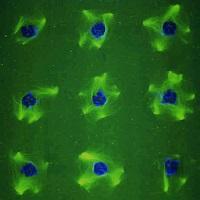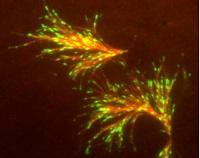Molecular architecture and function of the microtubule cytoskeleton
We are interested in understanding how cells acquire their shape, position organelles, move materials, and segregate chromosomes during cell division. These features are essential for life and organized by the microtubule cytoskeleton, which resembles the skeletal system that supports our human body. Each cell type and shape requires a specific microtubule architecture. For instance, long and bundled microtubules make up the axonal extensions of a nerve cell that can reach up to 1 meter in length, whereas a spherical microtubule network renders a lymphocyte perfectly round. In contrast to the human skeleton, the microtubule cytoskeleton is also highly dynamic. Most cells regularly undergo cell division, during which the cell-type specific interphase microtubule network is completely disassembled and replaced by short and dynamic microtubules of the mitotic spindle to capture, align and then segregate chromosomes.

How is a specific microtubule architecture established at the molecular level?
Microtubules are cylindrical and dynamic polymers that consist of the protein tubulin. The biological function of the microtubule cytoskeleton relies on the precise arrangement of microtubules in the cell. To achieve this organization, microtubule associated proteins generate, sever, polymerize, shrink, bundle, anchor, or move microtubules. We want to understand these functionalities mechanistically and use this insight to explain how they ultimately result in the self-organization of the microtubule cytoskeleton.
We employ two complementary approaches that allow us to look at structural detail of microtubule effectors and explain their function in the biological context. To study the mechanism by which microtubules are organized at a structural level, we use biophysical methods, electron microscopy and X-ray crystallography. To understand the dynamic assembly of the microtubule cytoskeleton, we combine biochemical and cell biological techniques along with advanced light microscopy methods.
Our goal is to identify and characterize new mechanisms that establish the cellular microtubule architecture. This will ultimately reveal how the microtubule cytoskeleton builds cellular structures to give cells their shape, position organelles, serve as tracks that move materials, generate force for movement, and segregate chromosomes.


